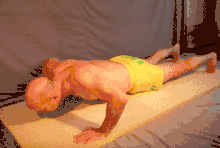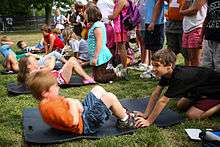Calisthenics
Calisthenics (American English) or callisthenics (Commonwealth English) are exercises consisting of a variety of gross motor movements—running, standing, grasping, pushing, etc. — often performed rhythmically and with minimal equipment, so essentially, bodyweight exercises. They are intended to increase body strength, body fitness, and flexibility, through movements such as pulling or pushing oneself up, bending, jumping, or swinging, using only one's body weight for resistance; usually conducted in concert with stretches. When performed vigorously and with variety, calisthenics can provide the benefits of muscular and aerobic conditioning, in addition to improving psychomotor skills such as balance, agility and coordination. Many consider calisthenics as "movement through space", meaning you can move freely without any restriction blocking your full strength.
Urban calisthenics are a form of street workout; calisthenics groups perform exercise routines in urban areas. Individuals and groups train to be able to perform advanced calisthenics skills such as muscle-ups, barspins, and both front and back levers.
Sports teams and military units often perform leader-directed group calisthenics as a form of synchronized physical training (often including a customized "call and response" routine) to increase group cohesion and discipline. Calisthenics are also popular as a component of physical education in primary and secondary schools over much of the globe.
In addition to general fitness, calisthenic exercises are often used as baseline physical evaluations for military organizations around the world. Two examples are the U.S. Army Physical Fitness Test and the U.S.M.C. Physical Fitness Test.
History
The word callisthenics comes from the ancient Greek words kallos (κάλλος), which means "beauty" or "beautiful" (to emphasize the aesthetic pleasure that derives from the perfection of the human body), and sthenos (σθένος), meaning "strength" (great mental strength, courage, strength and determination). It is the art of using one's bodyweight as resistance in order to develop physique. According to the Encyclopædia Britannica it was named after one of its earliest proponents, the Greek historian Callisthenes, even if it has been adapted to English with wrong spelling.
Disciples of Friedrich Ludwig Jahn brought their version of gymnastics to the United States, while Catherine Beecher and Dio Lewis set up physical education programs for women in the 19th century.[1] Organized systems of calisthenics in America took a back seat to competitive sports after the Battle of the Systems, when the states mandated physical education systems. The Royal Canadian Air Force's calisthenics program published in the 1960s helped to launch modern fitness culture.[2][3]
Calisthenics is associated with the rapidly growing international sport called street workout. Street workout as a sport consists of athletes competing against one other by each showing their body-weight strength and control in timed routines to impress a panel of judges. The World Street Workout & Calisthenics Federation (WSWCF) based in Latvia orchestrates the annual National Championships in up to 50 different countries (as of 2015) and hosts the World Championships for all the national champions to compete at one competition. The World Calisthenics Organization (WCO) based in Los Angeles, CA. promotes a series of competitions known globally as, Battle of the Bars(R). The WCO created the first ever set of rules for true 1 vs 1 competitions, including weight classes, timed round system, original judging criteria and a 10-point must system - giving the increasing number of athletes worldwide an opportunity to compete in these worldwide competitions.
Common exercises
In addition to the various stretches, some of the more common calisthenic exercises include:
- One of the basic calisthenics routines. Performed by a combination routine of a pull-up followed by a dip. May be done on pullup bars or rings.
- Performed by entering a squatting position, then using a plyometric jumping movement to jump as high as possible.
- A front lever is performed by lowering from an inverted hang until the body is completely horizontal and straight with the front of the body facing upwards. May be done on rings or pull-up bar.
- Performed face down on the floor, palms against floor under the shoulders, toes curled upwards against the floor. The arms are used to lift the body while maintaining a straight line from head to heel. The arms of the subject should go from fully extended in the high position to nearly fully flexed in the low position, while the subject makes sure to avoid resting on the floor. Resting is only done in the high position of the exercise. Chest, shoulders, and triceps are trained with this exercise. By furthering the range of motion, what is often called a push up, by pushing the shoulders downwards at the top the serratus anterior comes further into play.
- An overhead bar (sometimes called a chin-up bar) is grasped using a shoulder-width grip. The subject lifts their body up, chin level with the bar, and keeping the back straight throughout. The bar remains in front of the subject at all times. The subject then slowly returns to starting position in a slow controlled manner. This primarily trains the lats or upper back muscles, as well as the forearms. An underhand grip variation or chin-up trains both the back and biceps.
- Much like the pull-up, except that the hand placement is reversed. The hands are facing the person as he pulls his body up using the chin-up bar. The chin-up focuses on the biceps muscles, rather than the Latissimus dorsi muscle which is the focus of the pull up.[4]
- Standing with feet shoulder width apart, the subject squats down as far as possible, bringing the arms forward parallel to the floor. The subject then returns to standing position. Squats train the quadriceps, hamstrings, calves, and gluteal muscles.
- A back lever is performed by lowering from an inverted hang from rings or bar, until the gymnast's body is parallel to the ground and facing towards the floor.
- A handstand is the act of supporting the body in a stable, inverted vertical position by balancing on the hands. In a basic handstand the body is held straight with arms and legs fully extended, with hands spaced approximately shoulder-width apart.

- Done between parallel bars or facing either direction of trapezoid bars found in some gyms. Feet are crossed with either foot in front and the body is lowered until the elbows are in line with the shoulders. The subject then pushes up until the arms are fully extended, but without locking the elbows. Dips focus primarily on the chest, triceps, and deltoids, especially the anterior portion.
- Performed in a prone position on the ground, the individual raises the legs, arms and upper body off the ground.
- Lying on the back, hands in fists under buttocks, move feet up and down.
- This is the name for holding the 'top' position of a push-up for extended periods of time. The primary muscle involved in this exercise is the rectus abdominis.
- This is running back and forth between two points (or cones) typically separated by 5-40 meters, as fast as possible, with a touchdown. The emphasis should be on stopping, turning back and accelerate back to a sprint as quickly as possible.
- A full body calisthenics workout that works abdominal muscles, chest, arms, legs, and some parts of the back.
Calisthenics parks

There are a rising number of outdoor fitness training areas and outdoor gyms. Some are designed especially for calisthenics training. Calisthenics parks have equipment like pull up bars, monkey bar, parallel bar and wall bars at one location. The bars are connected to enable transfers between the elements.[5]
See also
References
- ↑ "calisthenics (exercise) -- Britannica Online Encyclopedia". Retrieved 2010-08-04.
- ↑ KRUCOFF, CAROL (1998-06-22). "Going Back to the Basics With Calisthenics". Los Angeles Times. ISSN 0458-3035. Retrieved 2018-10-08.
- ↑ "Five basic exercises for fitness in 1961". CBC Archives. Retrieved 2018-10-08.
- ↑ "Chin-Up Exercise Guide and Video". Bodybuilding.com.
- ↑ "Calisthenics Parks - Spots Map". calisthenics-parks.com. Retrieved 2016-12-30.

